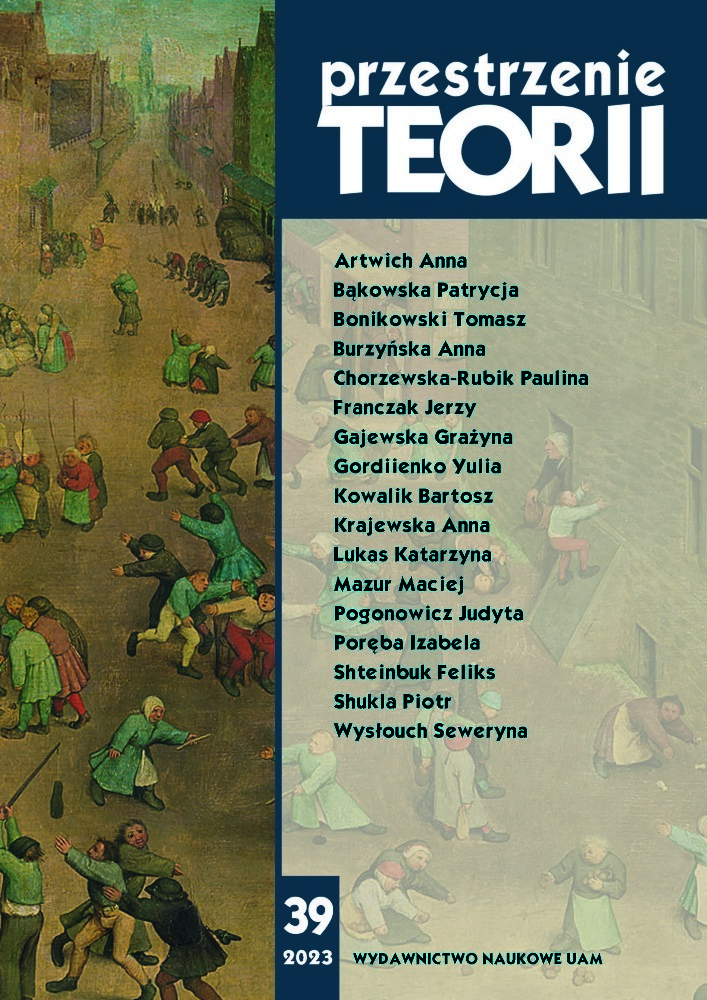Abstrakt
This article aims to analyze the use of parodic ekphrasis of the cathedral in Gustave Flaubert’s Madame Bovary. This matter was first brought to attention by Małgorzata Czermińska, who pointed out the satirical nature of the literary description of the gothic church in Rouen. However, to truly understand the way in which the novelist transformed the traditional formula of ekphrasis in Madame Bovary one must consider two drastically different dimensions of this treatment. The inspiration for this division comes from the work of Renata Lis, who argued that Flaubert’s work is marked by a fundamental ambivalence concerning spirituality, resulting in a variety of representations of holiness in his novels. On one hand, the parody of ekphrasis in the novel serves the most obvious function – it’s a cause for the mockery of the bourgeoisie and its distorted spiritual and aesthetic sensibilities. On the other hand, the parodic aspect of the discussed fragment is reminiscent of Olga Freudenberg’s approach. According to this Russian scholar, the essence of parody is not expressed through comedy and ridicule but rather through tragedy and an inseparable connection to the sacred. Such an understanding of the parodic ekphrasis of the gothic temple in Madame Bovary highlights the remarkable consistency with which Flaubert reflected on the existential condition of the protagonist. Emma’s inability to grasp the aesthetic values and sanctity of the cathedral expresses her tragic tendency to misrecognize, which leads to the novel’s somber finale.
Bibliografia
Flaubert G., Legenda o świętym Julianie Szpitalniku, przeł. R. Lis, [w:] tegoż, Trzy baśnie, przeł. R. Lis, J.M. Rymkiewicz, Warszawa 2009, s. 57-88.
Flaubert G., Pamiętniki szaleńca. Listopad, przeł. P. Śniedziewski, Warszawa 2021.
Flaubert G., Pani Bovary. Z obyczajów prowincji, przeł. R. Engelking, Warszawa 2020.
Barthes R., Mitologie, przeł. A. Dziadek, Warszawa 2020.
Bergson H., Śmiech. Esej o komizmie, przeł. S. Cichowicz, Warszawa 1995.
Czermińska M., Gotyk i pisarze, Gdańsk 2005.
Eliade M., Sacrum a profanum, przeł. B. Baran, Warszawa 2022.
Emery E., Romancing the Cathedral: Gothic Architecture in Fin-De-Siecle French Culture, Albany 2001.
Engelking R., Przedmowa, [w:], Gustave Flaubert, Pani Bovary. Z obyczajów prowincji, przeł. R. Engelking, Warszawa 2020, s. 5-22.
Freudenberg O., Pochodzenie parodii, przeł. A. Pomorski, [w:] tejże, Semantyka kultury, red. D. Ulicka, Kraków 2009, s. 43-45.
Lis R. (oprac.), Kalendarium, [w:] Trzy baśnie, przeł. R. Lis, J.M. Rymkiewicz, Warszawa 2009, s. 221-247.
Lis R., Ręka Flauberta, Warszawa 2011.
Nabokov V., Wykłady o literaturze, przeł. Z. Batko, Warszawa 2000, s. 229.
Parandowski J., Przedmowa, [w:] G. Flaubert, Pani Bovary, przeł. A. Micińska, Warszawa 1969, s. 5-31.
Rancière J., Dlaczego należało zabić Emmę Bovary? Literatura, demokracja i medycyna, przeł. J. Franczak, „Teksty Drugie” 2012, nr 4 (136), s. 143-159.
Simson O. von, Katedra gotycka, przeł. A. Palińska, Warszawa 1989.
Śniedziewski P., Kłopoty z „początkiem” – „Herodiada” Gustawa Flauberta, „Teksty Drugie” 2007, nr 3, s. 192.
Śniedziewski P., „Uciekałem w samotność…” – figury romantycznej samotności w Pamiętnikach szaleńca i Listopadzie Gustave’a Flauberta, [w:] G. Flaubert, Pamiętniki szaleńca. Listopad, przeł. P. Śniedziewski, Warszawa 2021, s. 213-241.
Wojkiewicz R., W spektrum Wyspiańskiego. Witraż w poezji Młodej Polski, Warszawa 2022.
Wysłouch S., Literatura a sztuki wizualne, Warszawa 1994.
Ziomek J., Retoryka opisowa, Wrocław 1990.
Licencja
Prawa autorskie (c) 2023 Piotr Shukla

Utwór dostępny jest na licencji Creative Commons Uznanie autorstwa – Użycie niekomercyjne – Bez utworów zależnych 4.0 Międzynarodowe.
Autorzy
Autorzy tekstów przyjętych do publikacji w czasopiśmie „Przestrzeniach Teorii” są zobowiązani do wypełnienia, podpisania i odesłania na adres redakcji umowy o udzielenie nieodpłatnej licencji do utworów, z zobowiązaniem do udzielania sublicencji CC.
Zgodnie z umową, autorzy tekstów opublikowanych w czasopiśmie „Przestrzeniach Teorii” udzielają Uniwersytetowi im. Adama Mickiewicza w Poznaniu niewyłącznej i nieodpłatnej licencji oraz zezwalą na użycie sublicencji Creative Commons Attribution-NonCommercial-NoDerivatives 4.0 International (CC BY-NC-ND 4.0).
Autorzy zachowują prawa do dalszego, swobodnego rozporządzania utworem.
Autorzy, którzy wykorzystują w swoim tekście cudze utwory (np. ilustracje, fotografie) proszeni są o dostarczenie do redakcji czasopisma zgodę na publikację od uprawnionych podmiotów.
Użytkownicy
Zainteresowani użytkownicy internetu uprawnieni są do korzystania z utworów opublikowanych po 2015 roku „Przestrzeniach Teorii” tylko w calach niekomercyjnych, pod następującymi warunkami:
- uznanie autorstwa - obowiązek podania wraz z rozpowszechnionym utworem, informacji, o autorstwie, tytule, źródle (odnośniki do oryginalnego utworu, DOI) oraz samej licencji;
- bez tworzenia utworów zależnych - utwór musi być zachowany w oryginalnej postaci, nie można bez zgody twórcy rozpowszechniać np. tłumaczeń, opracowań.
Do wszystkich tekstów opublikowanych przed 2015 r. prawa autorskie są zastrzeżone.
Inne
Uniwersytet im. Adama Mickiewicza w Poznaniu zachowuje prawo do czasopisma jako całości (układ, forma graficzna, tytuł, projekt okładki, logo itp.).

